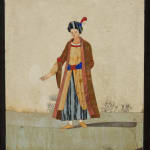Attributed to Antonio Ciocci (c. 1732-1792)
7 ¼ x 5 ½ in
Further images
Provenance
Private Collection, NetherlandsThomas Coulborn & Sons March 2013
Private Collection, USA
In an eighteenth century English fruitwood frame.
Antonio Ciocci was a painter and engraver in Florence in the second half of the eighteenth century. By 1770, he had been appointed Director of the Opficio delle Pietre Dure, the official Florentine body dedicated to the cutting of hard stone. He was responsible for the decoration of the Villa La Tana at Candeli and the ducal villa at Poggio Imperiale. Interestingly, as with this composition of a standing man, he often favoured the use of Egyptian porphyry as a ground. The export of pietra dura work was extremely important to the Florentine economy and the choice of Ottoman subject matter would no doubt have been influenced by the growing fashion for le goût turc at the French Royal Court.
'Soon after Marie-Antoinette ascended the throne in France in 1774, the young queen embraced a new fashion for interiors à la turc. This style grew out of a taste for neoclassical decoration initiated about 1770 by architects and designers who had studied ancient architecture in Italy. To the classical motifs, le goût turc called for the addition of turbaned figures, camels, crossed crescents, pearls, and other decorative elements associated with the Ottoman Empire. Such an eccentric style was reserved for the decoration of private spaces, boudoirs, or cabinets, which gave designers and architects more freedom than was permitted in public apartments at court or in aristocratic residences.' (from the introduction of the exhibition catalogue: Turkish Taste at the Court of Marie-Antoinette, held at the Frick Collection from 8th June - 11th September 2011).
The distinctive pose of the subject, with his right hand extended and pointing, was probably derived from a hand-coloured plate from Nicolas de Nicolay’s Les quatre premiers livres des navigations et pérégrinations orientales, Lyon 1567. An Italian edition of this very influential book was published as Le navigationi et viaggi nella Turchia, by Francesco Zileti, in Venice in 1580. The image also appears to have provided inspiration for a watercolour painted by Jacopo Ligozzi circa 1580 which, by the mid 18th Century, was in an album in the Gaddi Library in Florence. From there it provided inspiration for the design on a ceramic platter produced by the Doccia manufactory, Florence circa 1740.






